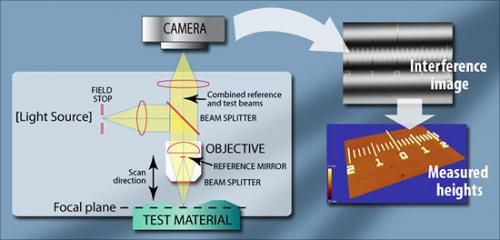
An optical profiler is an interference microscope, and it measures height variations on surfaces with great precision using the wavelength of light as the ruler.
Optical Profiling uses the wave properties of light to compare the optical path difference between a test surface and a reference surface. Inside an optical interference profiler, a light beam is split, reflecting half the beam from a test material which is passed through the focal plane of a microscope objective, and the other half of the split beam is reflected from the reference mirror.
When the distance from the beam splitter to the reference mirror is the same distance as the beam splitter is from the test surface, the recombined two beams are in phase, resulting in constructive interference and hence bright band. Dark band occurs due to destructive interference when the beam paths have the half wavelength difference. These light and dark bands known as interference fringes.
In the interference image (an “interferogram”), each transition from light to dark represents one-half a wavelength of difference between the reference path and the test path.
The reference mirror is as close to perfect flatness as possible; hence the optical path differences are due to height variances in the test surface. If the wavelength is known, it is possible to calculate height differences across a surface. A 3D surface map is obtained.